Online learning continues to revolutionize the learning experience for students of all ages. With an impressive 900% growth rate since 2000, the multi-billion dollar industry shows no signs of slowing down.
If you’re curious about what makes this massive industry tick, you’re in the right place. We’ve put together over 100 online learning statistics you need to know for 2024. Keep reading to discover the industry’s history, growth, users, and much more.
Online Industry Snapshot
| Market Size in 2024 | $185 billion |
|---|---|
| Market Size in 2029 | $270 billion |
| CAGR (2024 - 2029) | 8.56% |
| Key Market Drivers | Remote learning, internet adoption and smartphone use |
| ARPU 2024 | $210 |
Online Learning History and Timeline
While online learning now complements or competes against traditional education, it was pioneered by universities to reach out to untapped markets1.
- 1982: Computer-assisted learning center was established.
- 1994: Calcampus introduced the very first online learning program.
- 1997:California Virtual University (CVU) offered up to 1000 online courses.
- 2002: MIT introduced OpenCourseWare which stored a host of online course materials.
- 2007: Advance Learning Interactive Systems Online (ALISON), the very first MOOC, was launched.
- 2009: 5.5 million students took at least one online course.
- 2011: In October, Stanford released three free online courses2 which went on to attract over 100,000 students each. Udacity was launched by three former Stanford University3 professors as the outgrowth of the free computer science classes offered through Stanford.
- 2012: Harvard University and MIT launched edX, its non-profit MOOC.
- 2014: 98% of US public colleges offered online classes.
- 2015: Udacity joined the unicorn club4 with a $105 million Series D funding round4 that valued the business at $1 billion.
- 2020: Fueled by the pandemic and the widening global skills gap, online learning surged to new highs with 2020 being dubbed the year of the MOOC.
- 2021: Over 200 million students signed up for at least one MOOC. Coursera, recorded over 20 million new student registrations alone5, primarily from emerging economies.
- 2024: Udemy reported that the skills needed for jobs were increasing by 10% year-over-year. In response, the platform saw an increase in skills learning, recording more than 64 million learners on its platform.
Online Learning Industry Statistics
Online learning has seen a staggering growth rate of 900% since the year 20006.
This makes online learning the fastest-growing industry in global education.
According to Statista, the online learning industry encompasses user and revenue development across three key segments:
- Online University Education
- Online Learning Platforms
- Professional Certificates
Total online learning revenue across these segments is projected to grow at a CAGR of 8.56% between 2024 and 20297.
This will result in an estimated market volume of over $279 billion. Across the three segments mentioned earlier, revenue will be split as follows:
- Online University Education - $120 billion
- Online Learning Platforms - $58.5 billion
- Professional Certificates - $6.04 billion
In 2029, the number of users in the online learning market is expected to exceed 1.1 billion.
The highest number of users will come from the Asia Pacific (APAC) region, which will register an estimated 740.8 million users. Other regions include:
- Europe, Middle East, and Africa (EMEA) - 173.5 million users
- North America - 130 million users
- Latin America (LATAM) - 109.5 million users
- (Middle East and North Africa) MENA - 23.8 million users
Global online learning revenue is expected to reach $185.2 billion in 2024. This represents an 11.2% increase from 2023.
The most revenue will be generated in the US, with revenues expected to hit $87.5 billion in 2024, a 17% increase year-over-year. Projections for other key markets are as follows:
- In China, online learning revenue is expected to hit $45 billion in 2024, a 1.4% decrease from 2023.
- In the UK, online learning revenue is expected to hit $10.6 billion in 2024, a 12.4% increase.
- from 2023.
- In India, online learning revenue is expected to hit $6.7 billion in 2024, a 16.4% increase from 2023.
- In Canada, online learning revenue is expected to hit $6 billion in 2024, a 17.1% increase from 2023.
- In Japan, online learning revenue is expected to hit $4.7 billion in 2024, a 15.8% increase from 2023.
- In Australia, online learning revenue is expected to hit $4.4 billion, a 14.4% increase from 2023.
The global average revenue per user (ARPU) in the online learning market will reach $210 in 2024.
ARPU will be highest in North America at $1020, this is followed by:
- Australia and Oceania - $680
- The Americas at $660
- Central and Western Europe - $290
- Eastern Asia - $150
The MOOC (massive open online courses) market was worth $22.8 billion as of 2024, and is expected to hit $119 billion beyond 20298.
Between 2011 and 2021, learners reached by MOOCs increased from 300,000 to 220 million9. The MOOCs that have led to the success of online learning include:
- Coursera
- Udacity
- edX
- Udemy
- Code Academy
- UdemySkillShare
- Bright Space
- LinkedIn Learning
Meanwhile, between 2012 and 2019, the number of hybrid and online-only students increased by 36%.
By 2020, this had risen to 92%.
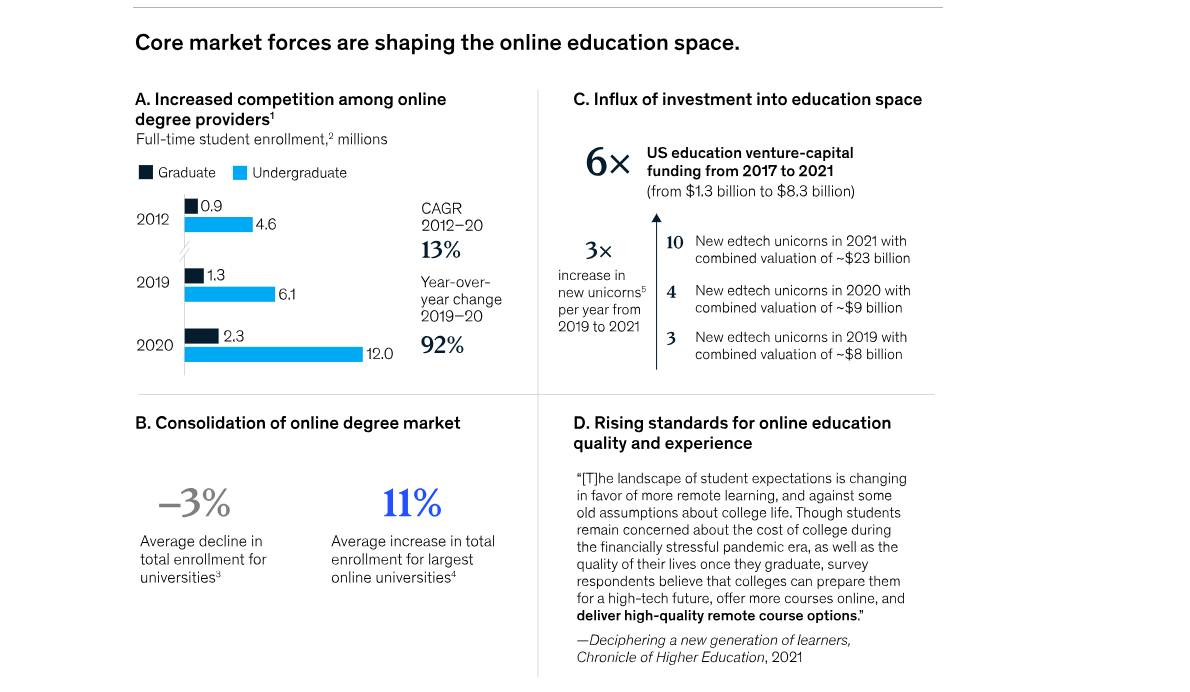
Online Learning User Statistics
In a 2024 report analyzing online college students, 65% of online students were women10, 51% were men, and 5% identified as non-binary or non-conforming.
This represents a shift from 2022 when only 48% of online students were women and men made up 51% of online students.
The same report found that:
- While the median age of undergrad online students was 29 and grad students was 32, the number of students under 25 was increasing.
- The online student population was predominantly 72% White, 21% Black, and 7% Asian.
- 51% of undergrads and 70% of grads worked full-time.
- A majority of students (22%) made under $25,000.
- 60% of online students wanted personalized content11 and 56% wanted the ability to learn on-demand.
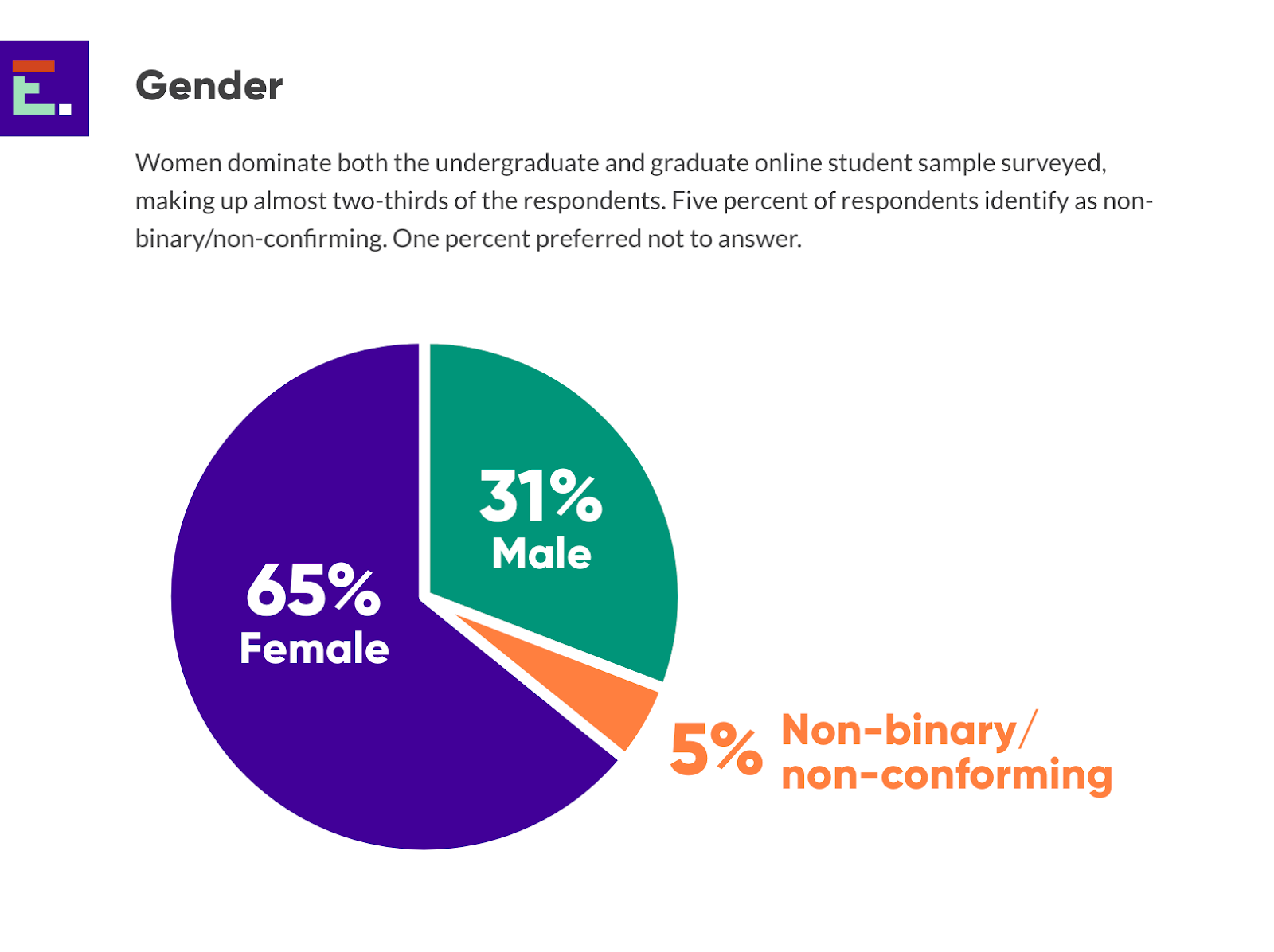
As per a 2024 Thinkific report on online learning, 92% of people dedicated at least one hour per month to learning digitally12.
Meanwhile, 62% of people were part of an online learning community.
In a 2023 study by McKinsey, 65% of students said they wanted certain aspects of the learning experience to remain virtual13.
Students also said they appreciated the convenience of online learning along with the following three aspects:
- Access to on-demand classes.
- Easy access to online study materials.
- The flexibility to work and study.
The same report found that many students still hesitated to enroll in online learning programs citing the top 3 reasons:
- Fear of being distracted by studying online.
- Lacking motivation due to being bored.
- Lacking the discipline to complete an online program.
Further, satisfaction with online learning experiences varied across countries.
In addition to having the largest growth in their online learning student bases, the US and Brazil had higher levels of student satisfaction on average.
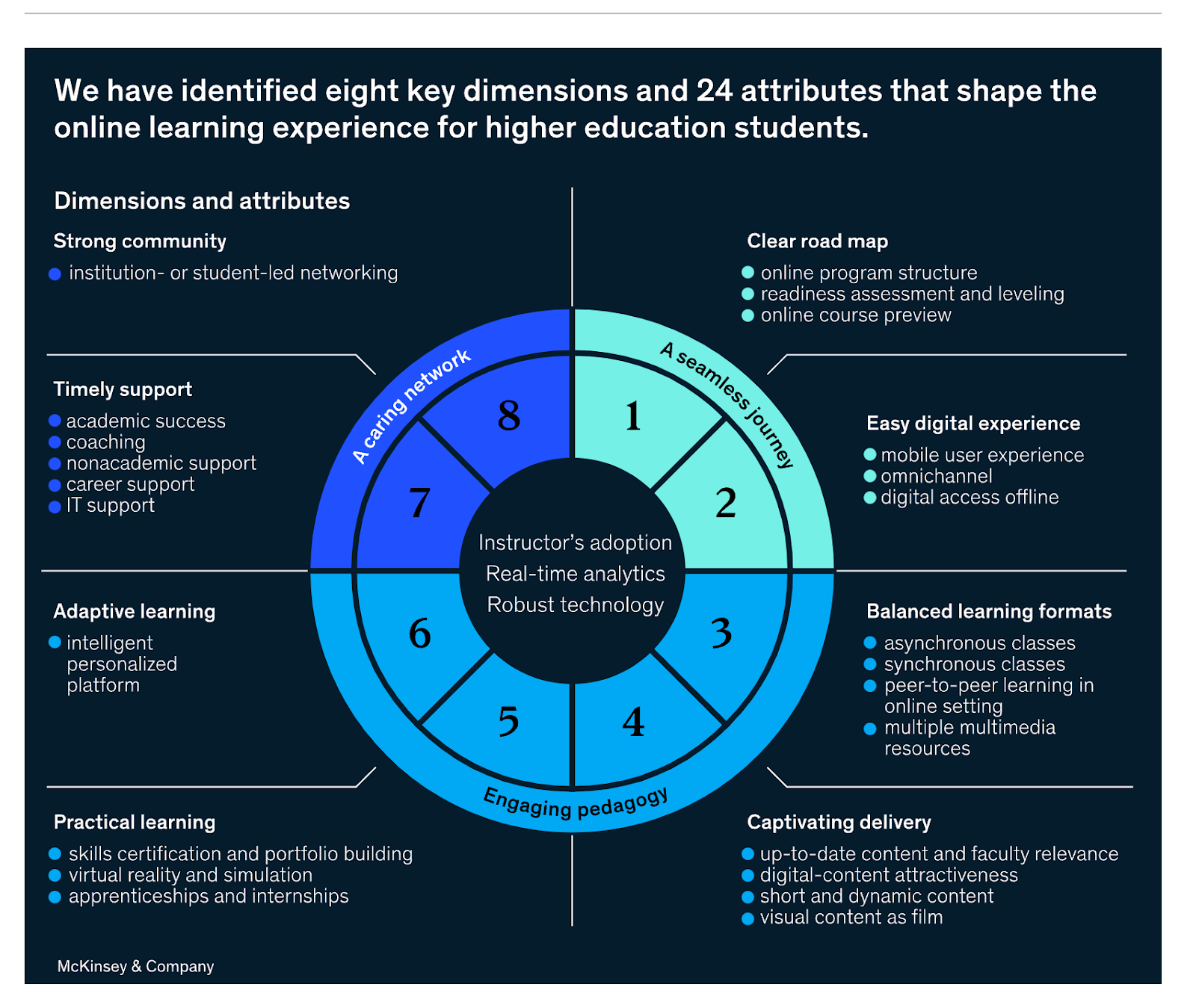
80% of students surveyed by the ICEF were pleased with their online experience14.
Students stated that the most common elements of their learning environment were:
- Recordings of live lessons - 76%
- Pre-recorded content and resources - 70%
- Online assessment and testing platforms - 60%
- Live streams of lectures - 49%
- A virtual learning environment - 49%
78.2% of students engaged in online learning would recommend it to others.
When asked about whether they would recommend online learning to others, a majority of students said they would, 16% were uncertain and 5,8% said no.
84% of students said they wanted more institutions to offer online learning.
Additionally, over 80% of these students said they would pursue further education if more online courses were available.
A 2022 report on the future of online learning found that 33% of people chose online platforms15 to learn new skills in 2022.
When it came to choosing online learning platforms by age:
- 16 to 24-year-olds preferred to take online short courses.
- 25 to 34-year-olds preferred training provided through work.
- 35 to 44-year-olds preferred part-time higher education online.
- 45 to 54-year-olds preferred to do their own self-guided study via YouTube, Google, etc.
Additionally, learning preferences were different across ethnic backgrounds. Asian (43%) and White (33%) learners named online learning platforms as their preferred method to gain new skills.
The same report found that learning directly with a brand or tech company such as TikTok or YouTube was more popular with Black respondents (38%).
Meanwhile, this form of learning was least popular among White respondents (11%).
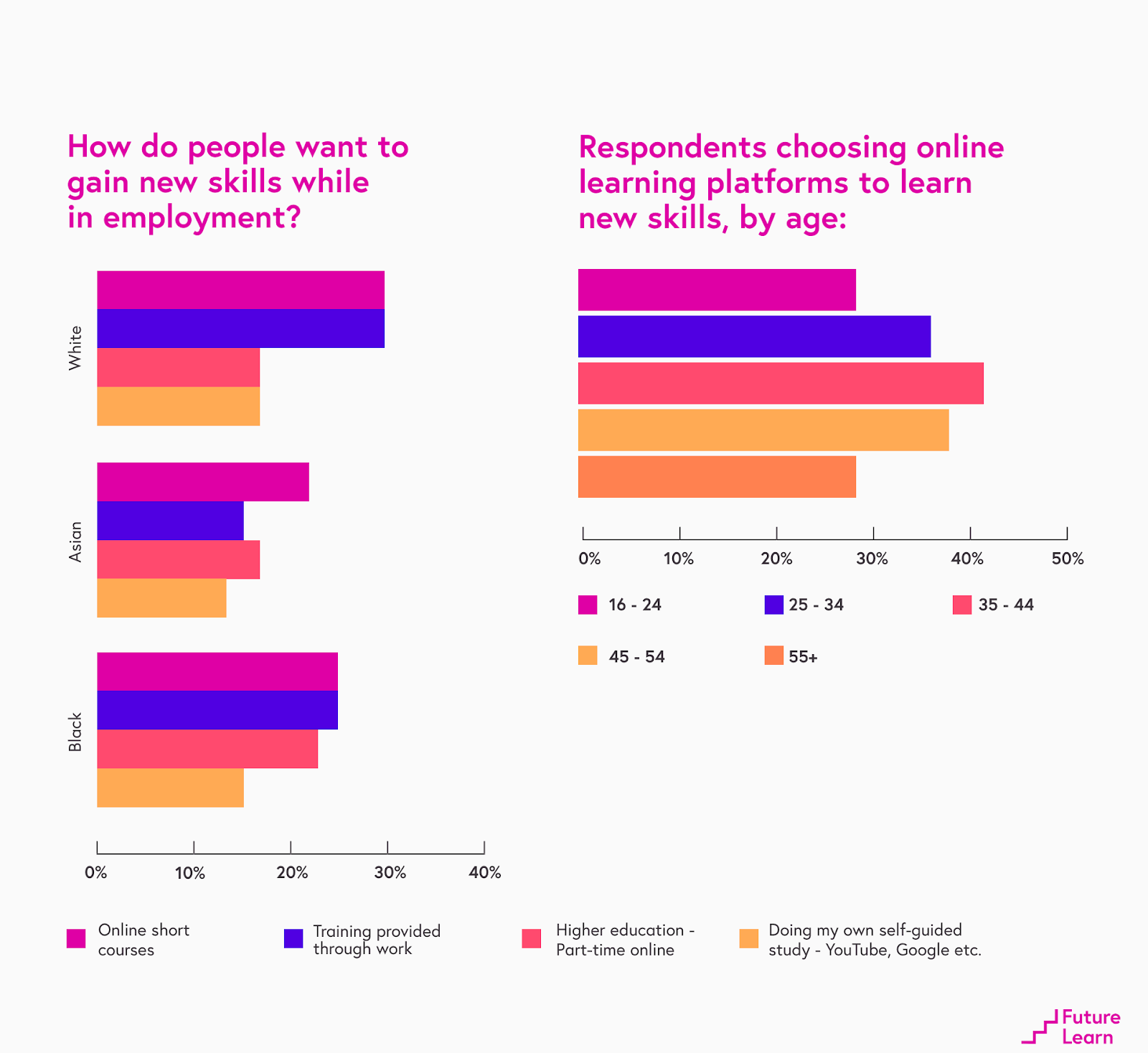
Overall, online courses were the top way to gain new skills to start a side business.
42% of respondents planned to enroll in an online learning program to help them start a side hustle.
In the US, over 53% of college students engaged in online learning in 2022.
This is down from 59% in 2021 and 73.4% in 2020.
The number of women in online learning increased from 38% in 2019 to 45% in 202116, with the overall gender gap in the industry showing a promising decline.
Additionally, research found that women were more likely to see online learning as more convenient and accessible than in-person learning. In fact, research by the IFC revealed that 45% of women and 60% of women caregivers in developing countries would stop or postpone their studies if online learning wasn’t an option.
In 2021, 86% of Gen Zs engaged in online learning to build hard and soft skills17.
Additionally, this generation spent 12% more of their private time on online learning platforms than the average learner.
Online Learning Platform Statistics
As of 2024, the top two most well-known online learning platforms in the US were language learning tools Rosetta Stone and Babbel18, with brand awareness rates of 61% and 51% respectively.
This was followed by:
- LinkedIn Learning - 45%
- Duolingo - 43%
- Khan Academy - 39%
- Coursera - 34%
- Harvard Extension School - 34%
- Masterclass - 32%
- Stanford Online - 31%
- Skillshare - 28%
- Udemy - 27%
- Open Yale Courses - 26%
- Princeton Online - 26%
- Codecademy - 24%
- Learn Worlds - 23%
- Udacity - 22%
- edX - 20%
- FutureLearn - 20%
- Pluralsight - 20%
Online learning platforms are expected to generate $58.5 billion in 202419, up close to 2% from 2023.
Globally, the most revenue will be generated in China ($40.6 billion in 2024). Further, between 2024 and 2029, revenue is expected to grow at a CAGR of 5.3% to exceed $75.5 billion.
Worldwide, user penetration in 2024 will be 13.5%, with an estimated average revenue of $74.59.
Again, China leads with a 21.9% penetration rate. By 2029, users in the online platforms market are expected to hit 1 billion.
The most visited online education website in the world as of April 2024 was LMS provider Instructure20 with over 456 million visits.
This was followed by:
- Scribd with 178.5 million total visits.
- Quizlet with 133.3 million total visits.
- ByJus with 119.1 million total visits.
- Udemy with 101.2 million total visits.
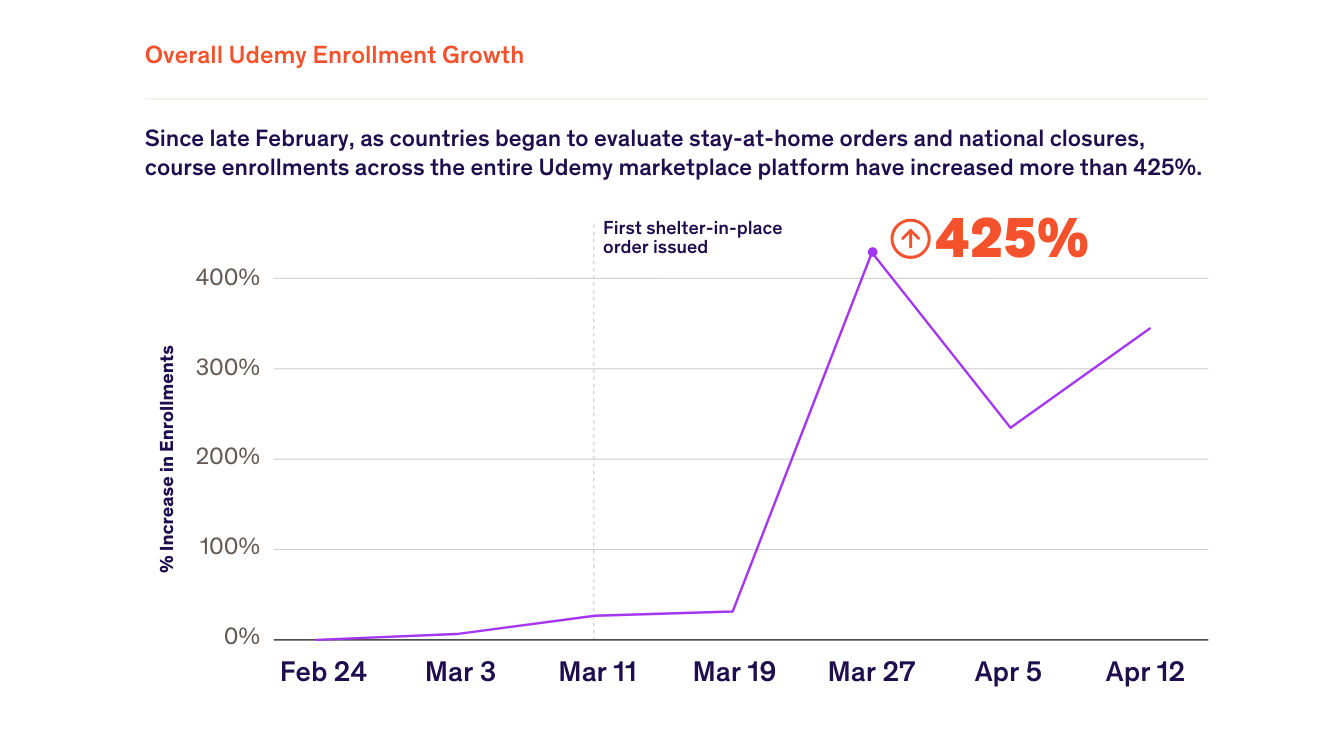
With over $500 million in funding and over 118 million learners as of April 2023, Coursera was the largest MOOC platform in the world.
In 2021, Coursera recorded a whopping 189 million enrollments, up from 26 million in 2016. In addition, the platform had over 92 million registered users, up from 21 million users in 2016.
EdX, also among the largest MOOC platforms, had over 46 million learners in 2023.
In a shift away from its non-profit status, edX was acquired by 2U for $800 million in 2021.
In 2020, a Udemy report noted a 425% increase in enrollments for consumers21 driven largely by pandemic lockdown orders.
Online learning surges were highest in the following countries:
- Italy - 320%
- Spain - 280%
- India - 200%
The same report also noted an 80% increase in usage by businesses and governments over the same period.
In response to the demand for online learning, course creation increased by 55%.
Online Learning Costs Statistics
The average cost of an online bachelor's degree was between $40,926 and $63,40522 as of February 2024.
Additionally, the average credit price for online programs was $516 compared to $1,123 for on-campus students at private colleges. On the other hand, the average credit price at a public college was $338 per credit for an online bachelor's degree compared to $331 per credit on campus.
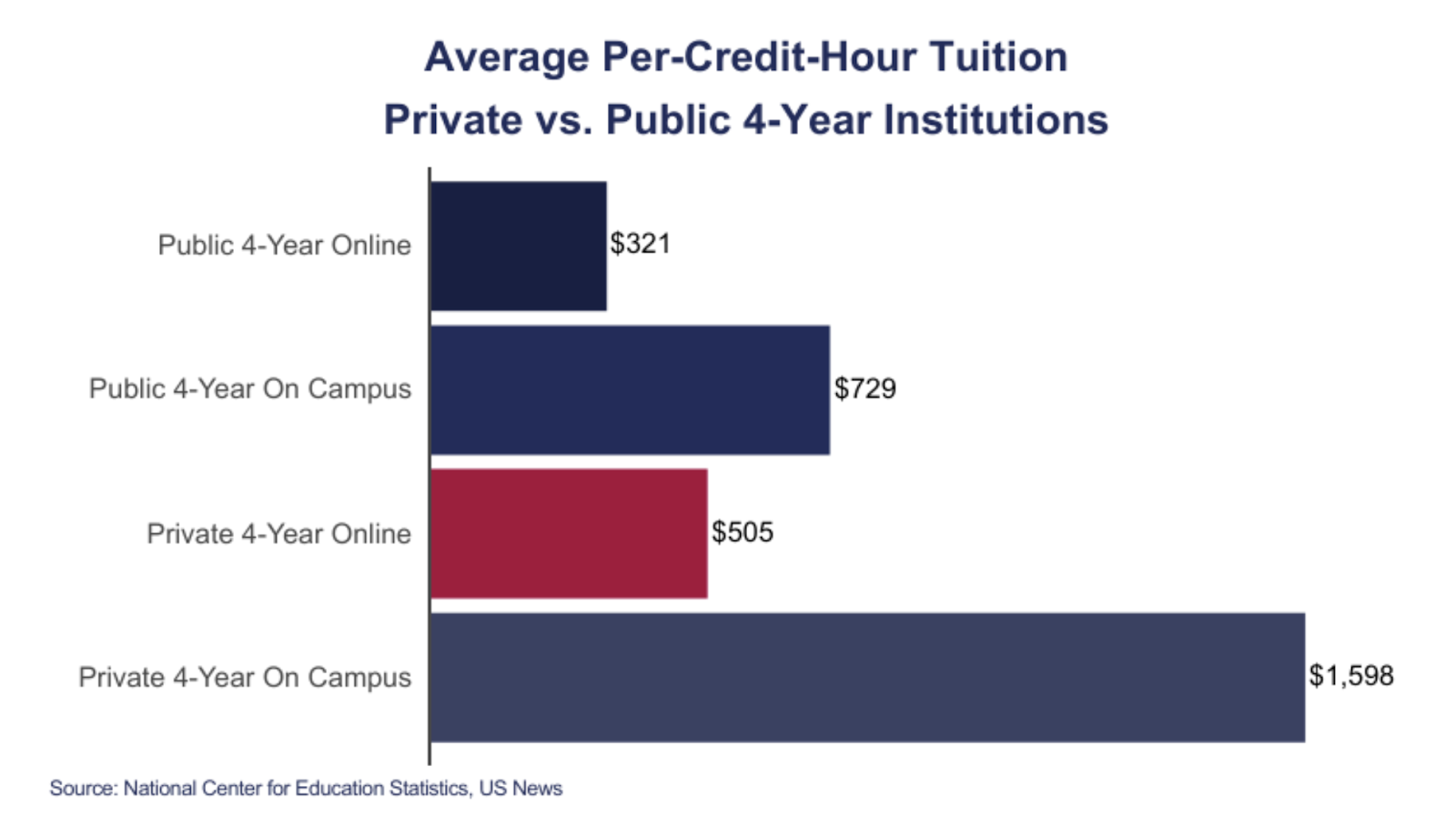
A key draw of online learning is its cost-effectiveness23. For example in 2023:
- Online degrees were on average $31,165 cheaper than 4-year in-person degree programs at public colleges.
- At private institutions, online degrees were on average $124,000 cheaper than in-person degrees.
- Online students saved an average of $1,360 per year on transportation costs and an average of $600 on meals.
- Online degrees at public universities were roughly $30,000 cheaper than in-person degrees.
Meanwhile, nanodegrees cost around $200 to $400 a month24.
This means students can expect to pay between $1200 - $2400 for a 6-month nanodegree and $2,400 - $4,800 for a 12 month nanodegree.
On various platforms, MOOCs cost anywhere up to $200 per course or between $30 and $60 per month subscription.
However, some courses can be accessed for free through audit mode or by applying for financial aid.
The average online course cost around $13725 in 2021.
Online courses cost anywhere between $0 and $304, highlighting their variability. However, research found that 89% of all online courses cost under $350.
Online Learning Technology Statistics
In 2025, global spending on EdTech is expected to increase across several key segments.
The largest increase will be in the virtual reality segment26, which is forecasted to increase from $1.6 billion in 2018 to an impressive $12.6 billion in 2025.
Other key segments include:
- Artificial intelligence, which is expected to increase from $0.8 billion in 2018 to $6.1 billion in 2025.
- Robotics, which is expected to increase from $1.3 billion in 2018 to $3.1 billion in 2025.
- Blockchain, which is expected to increase from $0.1 billion in 2018 to $0.6 billion in 2025.
As of January 2024, 2.6 billion people (one-third of the global population) lacked access to the internet27, forming a barrier to online development opportunities or a digital divide.
Additionally, 93% of people in high-income countries used the Internet, compared with only 27% in low-income countries.
With a valuation of $22 billion as of January 2023, ByJu, an Indian company28, was the most valuable EdTech unicorn worldwide.
In second place was US company BetterUp, with a valuation of $4.7 billion, followed by:
- Guild Education (US) - $4.4 billion
- Articulate (US) - $3.75 billion
- Course Hero (US) - $3.6 billion
Online learning reduced energy consumption by up to 90% compared to classroom learning according to the previously mentioned 2022 study by Oxford.
From energy saving on lighting, temperature control, and travel, online learning has a smaller energy footprint than traditional face-to-face learning.
The global market for VR education increased from $6.4 billion to $8.7 billion in 2022.
Meanwhile, 89% of students in the 2022 Oxford study thought the use of virtual reality (VR) could somewhat improve online learning. A further 49% of these students said that an online course having a VR element would encourage them to sign up.
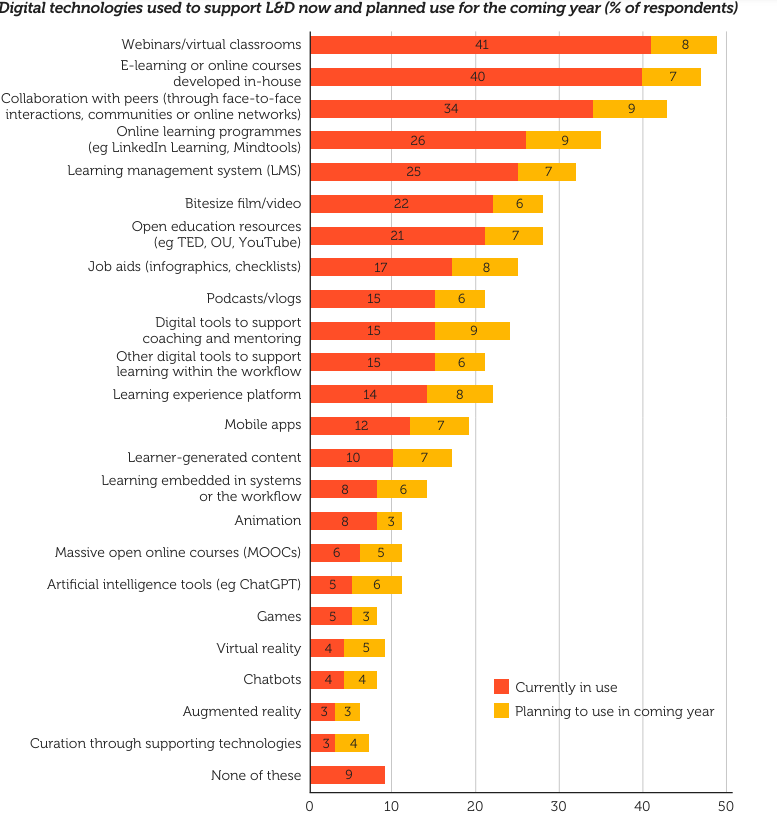
In a CIPD report, webinars remained the most popular tool for online learning29 with a usage rate of 41%.
Other stand-out technologies included:
- Learner-generated content - 10% adoption rate.
- Mobile apps - 12% adoption rate.
- Virtual reality - 4% adoption rate.
- Augmented reality - 3% adoption rate.
In 2021, the pandemic drove the mainstream use of edtech segments such as video conferencing30 which experienced a 36% jump to 87% adoption.
Video recording and distribution tools also saw higher adoption rates, moving into majority territory (60%) for the first time. In addition, the adoption of:
- Accessibility tools hit 51% in 2021.
- Online textbooks and materials hit 40% in 2021.
- Assessment Integrity hit 49% in 2021.
Between 2017 and 2021, US venture funding for Edtech increased from $1 billion to $8 billion.
2021 in particular, saw the successful IPO of multiple edtech companies such as Coursera, which was valued at over $4 billion.
Mobile Online Learning Statistics
The global mobile learning market is projected to be worth over $48.2 billion in 202431, up from $39.7 billion in 2023.
By 2029, the market is expected to grow at a CAGR of 21.5% to hit $127 billion by 2029. This will be driven by the widespread use of mobile devices, and the growing demand for mobile learning.
Key market players in the global mobile learning market include:
- Upside learning
- Dell
- SAP
- SweetRush
- Epic Learning Group
- City & Guilds Kineo
As of January 2024, there were over 5.6 billion unique mobile users worldwide, directly contributing to the rising demand32 for mobile learning.
Meanwhile, the number of cellular connections associated with smartphones continues to rise, with almost 7 billion smartphones in use today.
There were over 455,000 education apps on the Google Play and Apple App store33 in 2022.
This represents a 51% increase from just under 250,000 mobile education apps available in 2014.
Additionally:
- Annual education app downloads doubled from 2 billion in 2017 to 4 billion in 2022.
- Annual revenue in the education app market increased from around $4 billion in 2017 to 7 billion in 2022.
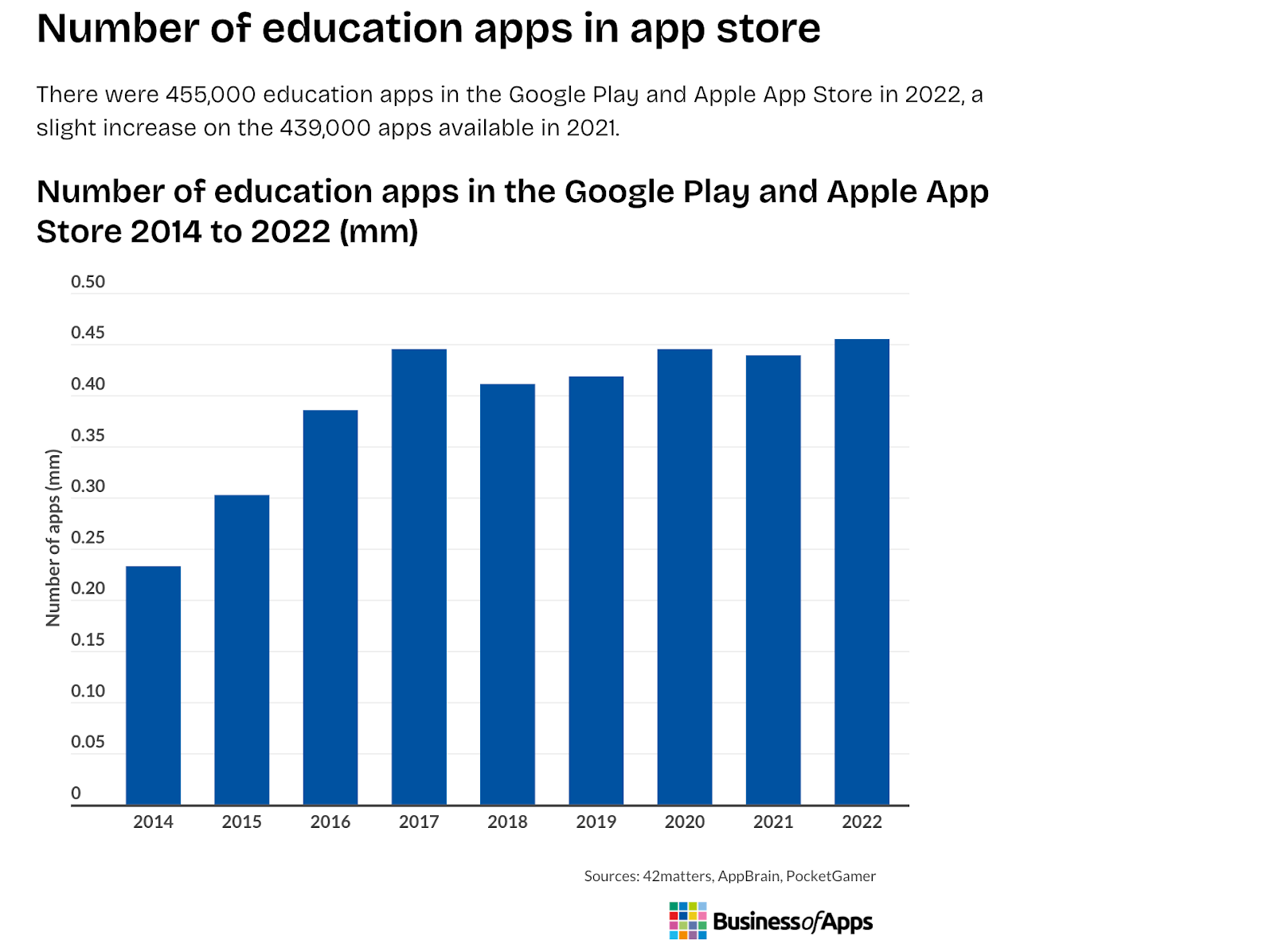
Duolingo was the most downloaded education app34 in 2023, with 148 million downloads from 98 million in 2022.
This was followed by:
- Brainly - 46 million users
- Photomath - 39 million users
- Baby Panda’s School Bus - 34 million users
Duolingo also had the most registered users in 2022 with over 500 million registered users.
This was followed by apps such as:
- Brainly - 350 million users
- ClassDojo - 100 million users
- BYJU - 115 million users
Online Learning and AI statistics
In 2024, Coursera launched its Generative AI Academy35. Generative AI for Everyone by Deep Learning AI was the most popular course of 2023 with 65,000 learners enrolled in the first 2 weeks.
Together with its partners, the online learning platform offered other popular courses such as:
- Prompt Engineering for ChatGPT(Vanderbilt University)
- Introduction to Generative AI (Google Cloud)
- Generative AI with LLMs (DeepLearningAI)
78% of people believed AI-generated content was here to stay in 2023.
Additionally, MIT research found that people who didn’t know the source of learning content frequently preferred AI-generated content.
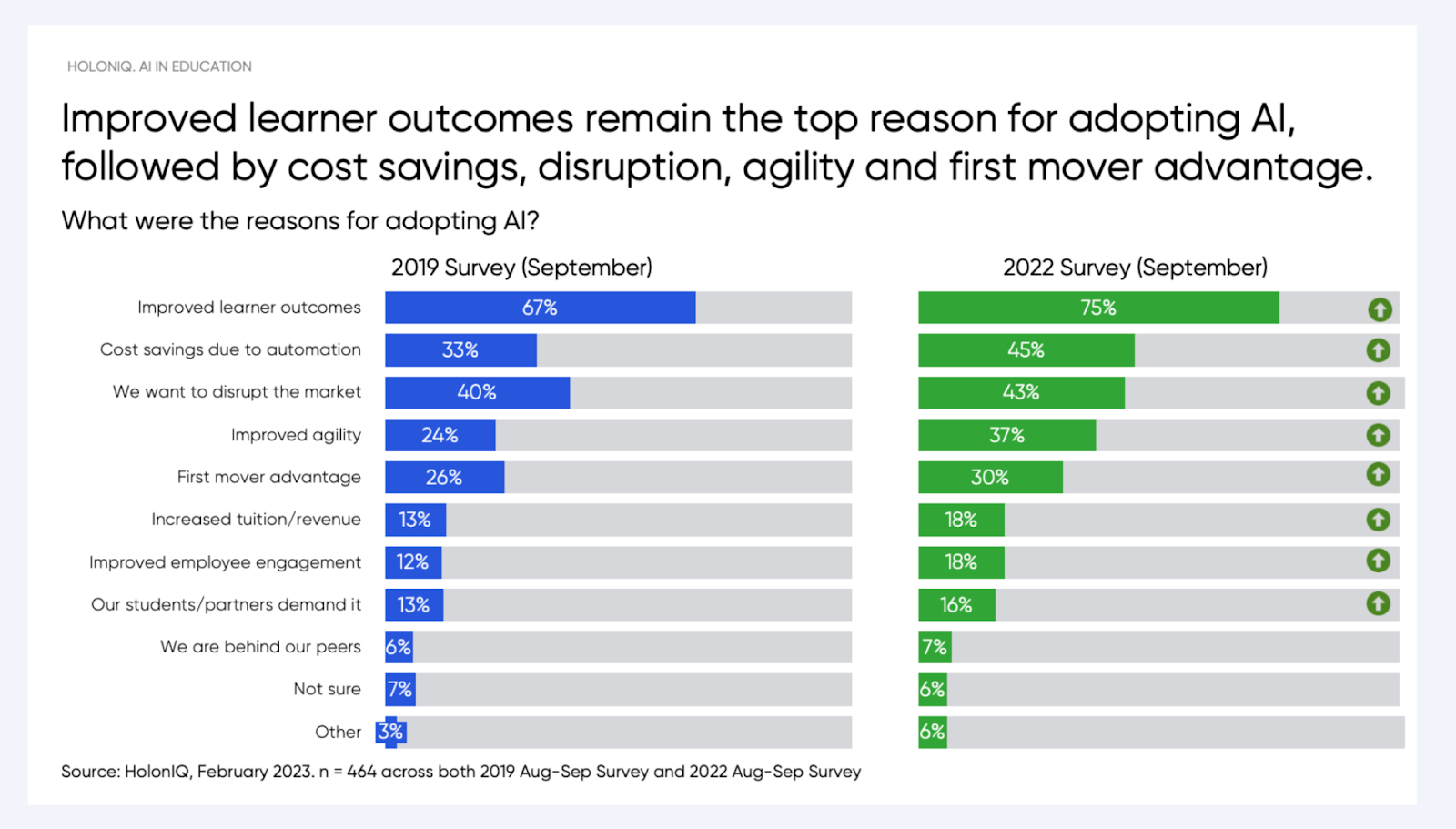
In a 2023 study about the impact of AI on education, Analytics AI and Language AI were perceived to have the highest potential impact36 (83% and 86% respectively).
Improved learner outcomes(75%) were the top reason for adopting AI. This was followed by:
- Cost savings - 45%
- Market disruption - 43%
- Improved agility - 24%
- First mover advantage - 26%
Additionally, it was found that up to 70% of repetitive educator tasks could be automated by AI37.
This would free up more time for educators to plan lessons, teach and engage learners.
Online Learning vs In-Person Learning Statistics
The previously mentioned CIPD report found that the use of online learning continues to increase while face-to-face learning declines.
While not at peak pandemic levels, the use of digital solutions increased by 42% while investment in learning technology increased by 16%.
The same report found that large organizations were 53% more likely to report an increase in their use of online learning solutions, and 31% more likely to report an increase in their investment in learning technology.
This is compared to just 19% and 37% of SMEs respectively. In fact, 55% of SMEs were more likely to report that their use of face-to-face solutions remained the same.
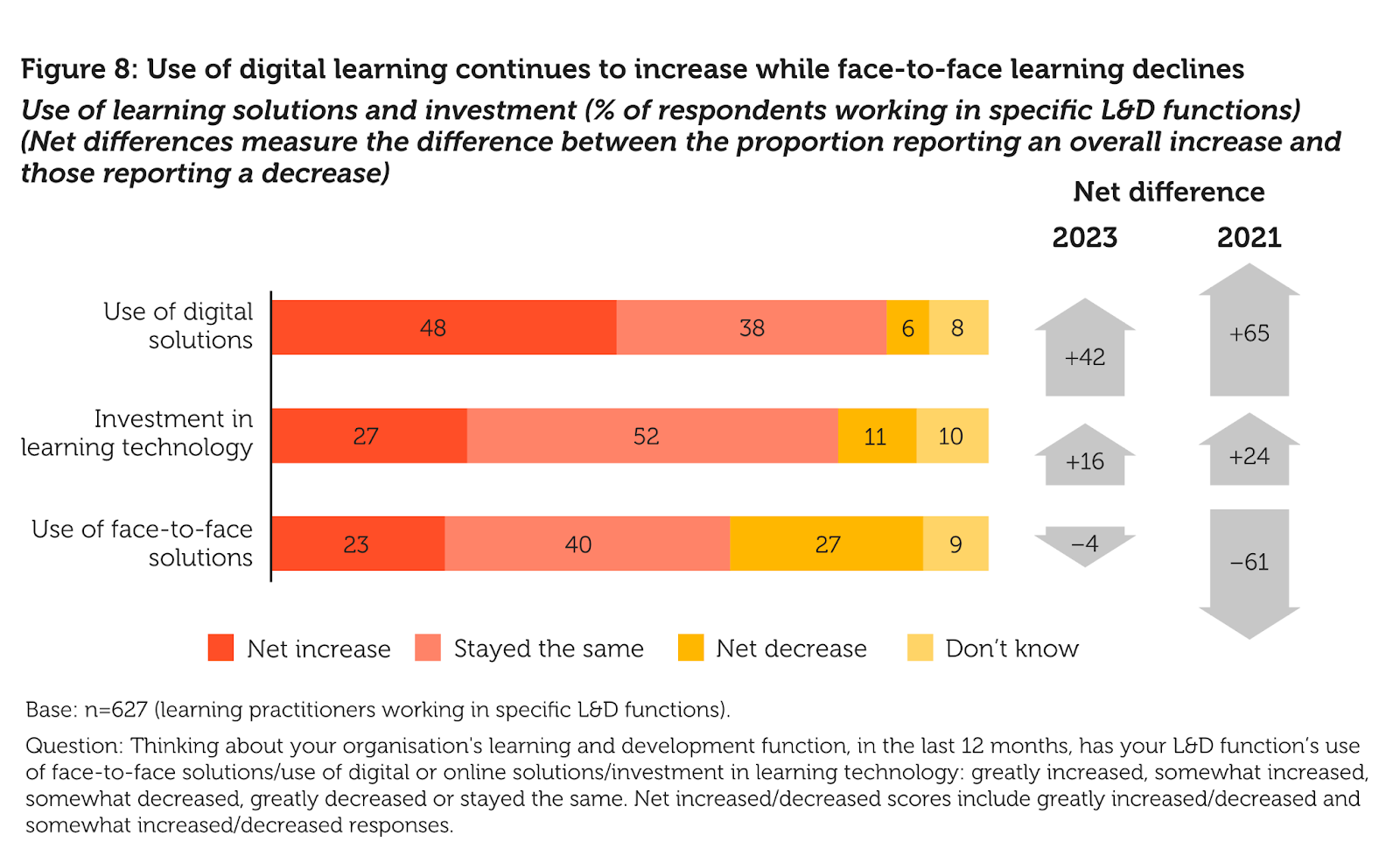
When asked about whether they found online learning easier than in-person learning, 36.9% of students in the Oxford report said they found online learning easier.
The same study found that 34% of students actually felt in-person learning was easier. Meanwhile, 29.1% felt both types of learning were the same.
Digging deeper into why a majority of students preferred online learning, 84% said they liked its flexibility.
The second most popular reason was being able to study at their own pace, with over 81% of students selecting this option. Other key reasons included:
- Accessibility - 55.8%
- Less travel - 38.8%
- Choice of courses - 35.9%
- Cost - 26.7%
- Career advancement - 25.7%
On the other hand, when asked about what they didn't like about online learning, 53.4% of students cited the lack of in-person support.
The second most popular answer was missing out on social interaction, with 45.6% of students selecting this option. Other key reasons included:
- Lack of practical training - 41.3%
- The need for self-motivation to learn - 40.3%
- Working only on a computer - 30.1%
Online Learning on Social Media Statistics
According to the previously mentioned Thinkific report, 80% of social media users consumed downloadable learning content from someone they follow on social media.
Online educational content creators continue to take their monetization efforts to social media providing downloadable guides, ebooks, templates, Q&As, and mini-courses to their followers.
40% of young people used TikTok or Instagram for search instead of Google, highlighting a growing trend toward social media as an online learning tool.
The figure increased to 47% for adults aged 18 to 25 who said they used TikTok for learning.
YouTube has emerged as an online learning platform with 67% of Millenials and 82% of Gen Zers preferring YouTube over other learning platforms.
Channels like Crash Course (15.1 million subscribers) are amassing eager viewers. Khan Academy (8.14 million subscribers) and AsapSCIENCE (10.4 million subscribers) are also examples of learning channels with a massive following.
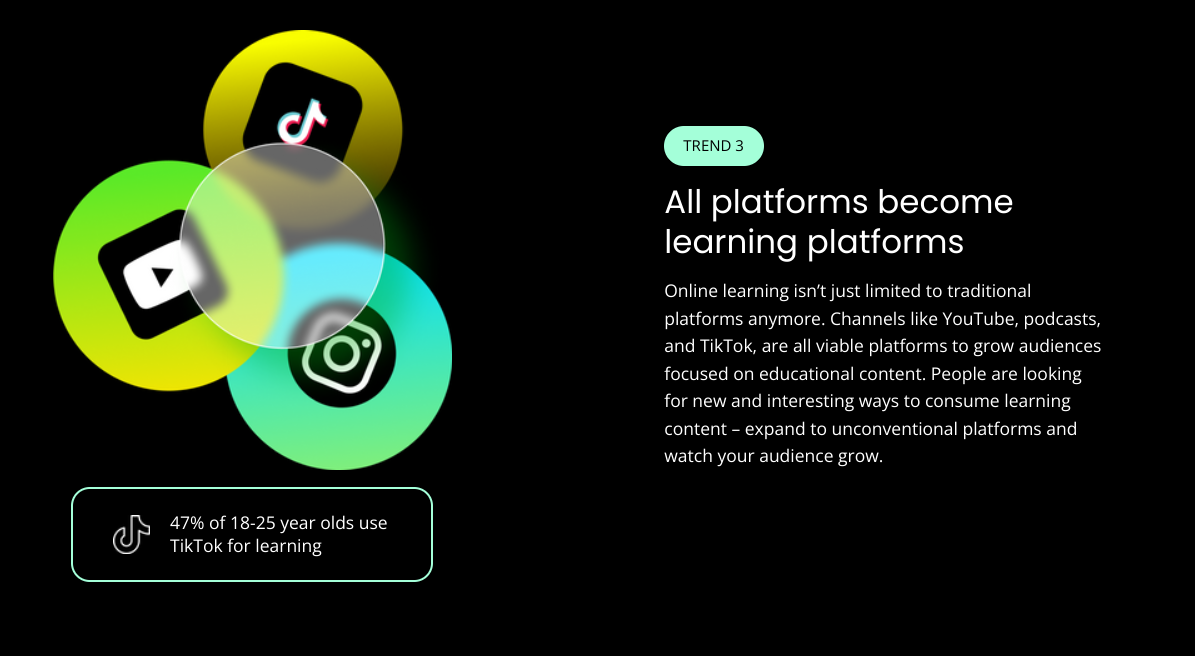
39% of consumers who use online communities do so to learn new things.
While public communities such as Facebook groups and subreddits remain popular, over 50% of people now prefer to learn from private chats or communities (eg. private Discord communities).
62% of people are more interested in creators who create online learning content than those who create content for entertainment purposes.
That’s up 5% from 57% in 2023, highlighting a shift away from entertainers towards educators on social media.
Online Learning in the Workforce Statistics
With 1.1 billion jobs set to be transformed by technology in the coming decade, the WEF estimates that over 50% of the global labor force will need reskilling between 2024 and 2026.
Online learning will play a major role by accelerating upskilling and closing the global talent gap.
72% of businesses reported that online learning put their companies at a competitive advantage.
Online learning is increasingly being used by corporations to upskill their workforces and secure a competitive edge.
The same report found that 83% of CEOs viewed e-learning certificates as credible as university degrees.
They also noted a $30 on average return for every dollar invested in online learning platforms.
According to a 2023 report by Coursera, 77% of learners and 91% in developing economies reported career benefits like getting a job, getting a promotion, and more38.
The same report found that:
- 95% of learners and 99% in developing economies reported personal benefits, such as gaining more confidence, feeling more accomplished, and more.
- 30% of unemployed learners were employed after completing their most recent course or program.
- 25% of entry-level professional certificate completers got a new job.

A Udemy report found that total learning hours of technical skills increased by 49% in 2023 on Udemy Business39.
The report suggested that the pandemic accelerated digital adoption by five years, resulting in massive skill shifts. Demand for technical skills was also compounded by the fact that technical skills tend to lose relevance in 2.5 years — twice as fast as other types of skills.
Additionally:
- More than 58% of workforces reported skill transformations brought on by the pandemic.
- 30% of the skills required three years ago would be obsolete.
- 77% of global workers were ready to learn new skills and saw training as a matter of personal responsibility.
Similarly, in the same year, Udacity reported that 80% of its graduates40 reported a positive career benefit.
In addition, 33% of graduates reported concrete employment outcomes such as a new job or promotion.
42% of organizations experienced an increase in income after introducing online learning.
According to the 2022 Oxford study, companies that used online learning as part of their training process noticed a considerable increase in revenue as a result.
A 2022 Wiley report found that nearly 50% of online learners with employer-sponsored tuition benefits didn’t use them41.
Learners cited worrying that employer benefits wouldn’t cover tuition and that they’d have to pay back their employer if they left the company before finishing their program.
Join the Online Learning Movement With Whop
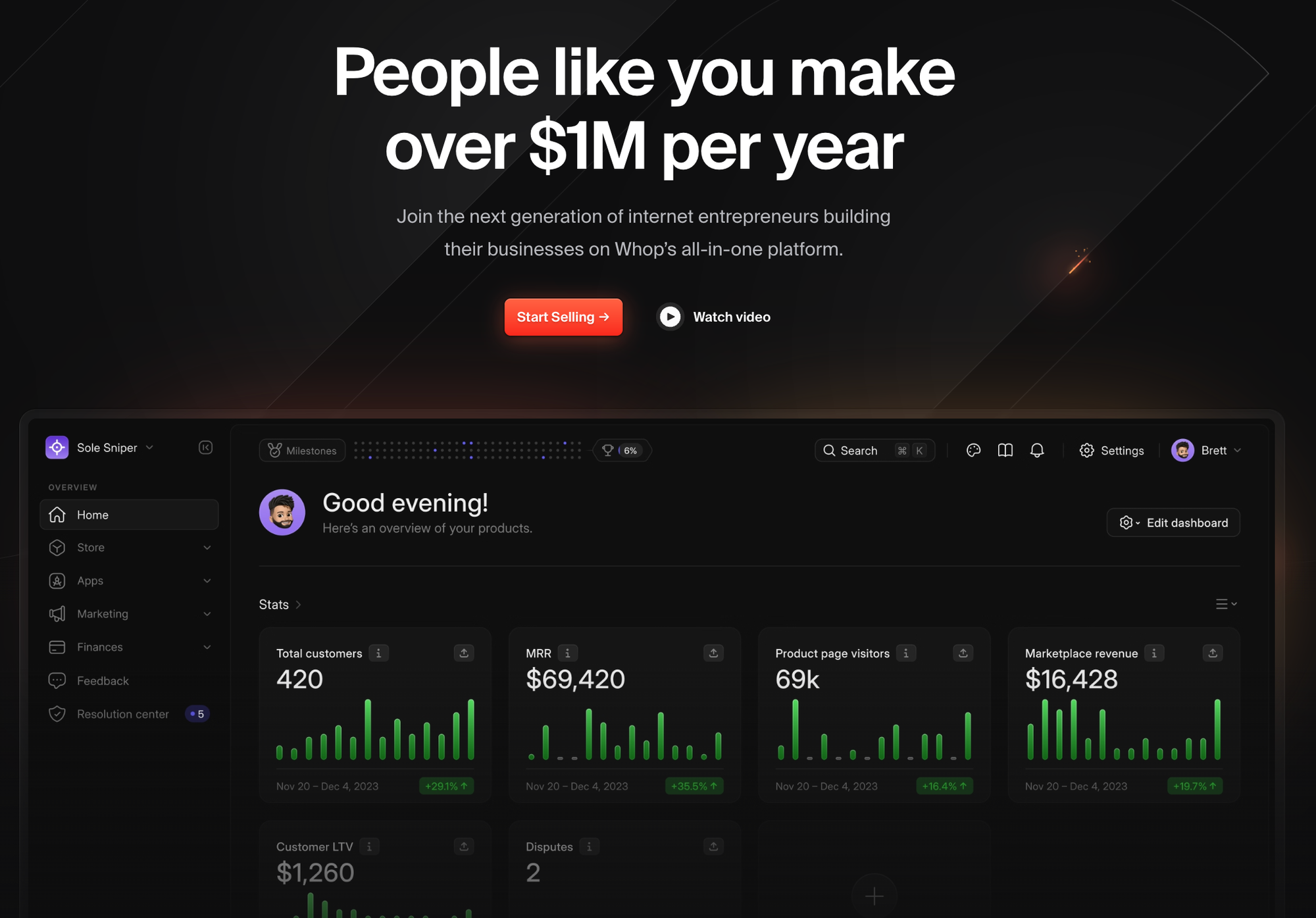
The online learning sector is a multi-billion dollar industry, one that has grown 900% since 2000. The way we learn online is changing - why not become a part of this growing sector and sell your own online course?
With Whop you can easily transform your knowledge, skills, or experience into an online course, masterclass, webinar or even an educational paid community. You simply set up your hub on Whop (for free), add the apps that you want to use, and start charging access! To find out more and start sharing your skills online, check out Whop today.
FAQs
How effective is online learning?
Online learning is highly effective, boasting key benefits such as improved learning outcomes, convenience, flexibility, and cost-effectiveness.
What is the dropout rate for online learning?
Dropout rates for online learning are between 40% and 80%.
Sources
Reference List
- Grow Enrollments
- Class Central
- Zippia
- Pitchbook
- Weforum
- Oxford College
- Statista
- Mordor Intelligence
- McKinsey
- Education Dynamics
- Study
- Thinkific
- McKinsey
- ICEF
- FutureLearn
- Weforum
- Aerotime
- Statista
- Statista
- Similarweb
- Udemy
- US News
- Education Data
- Mastersportal
- Podia
- Statista
- Weforum
- Statista
- CIPD
- Quality Matters
- Market Data Forecast
- Data Reportal
- Business of Apps
- Apptopia
- SHRM
- Holoniq
- Forbes
- Coursera
- Udemy
- Udacity
- Wiley





